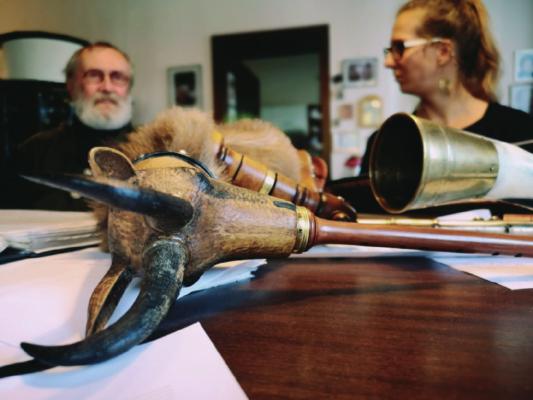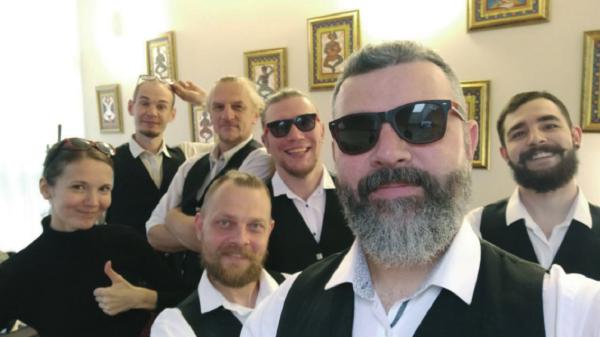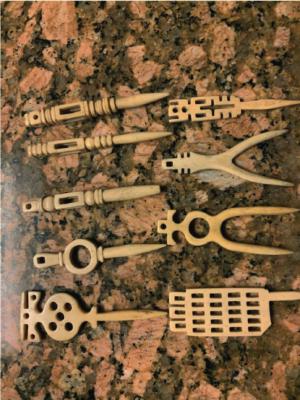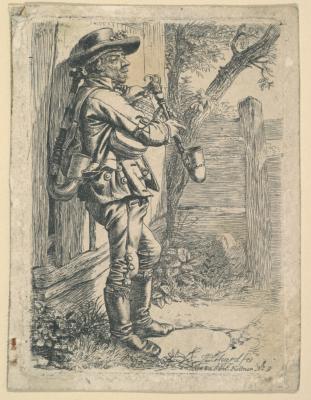The Bagpipe Society
Grace Notes

Just a few short notes from me as there is yet another packed edition awaiting you. Again, there’s an eclectic mix of articles and I hope you will find something of interest.
The Bagpipe Society has a broad church of membership and I know that some are primarily interested in history, others in making and research and others more focused on simply playing the instrument. I am, as ever, grateful to all the contributors who have taken the time to write for Chanter and have succumbed to my reminders and prompts to get the articles to me on time! I clearly am doing something right as, following each edition, I have a trickle of emails thanking me and wondering how I do it! I think the same myself but, somehow, each edition manages to fill up just in time! However ….. I am always looking for ideas and inspiration and, most of all, contributions! I would also be interested in hearing from anyone who fancies being a ‘Guest Editor’ for an edition. So, if you have suggestions or if you’d like to put together your own ‘ideal Chanter’ with support and DTP skills provided, then please get in touch with me at janethepiper@gmail.com
The IBO conference in March was a fantastic event and I reported on it in the summer edition. I am pleased to be able to feature articles by two of the presenters who were there, Estibaliz Santamaria Cadaval and Juris Lipnis. I was fascinated to hear the story of how the gaita travelled to Cuba and became a fixture of the musical scene on the island and so am especially pleased that Liz has recounted the journey for members of The Bagpipe Society. From Latvia, Juris gives us an overview of the bagpipes of Latvia and how a small area of the country revived its own piping tradition. I know I’m not the only person who goes to a new town and when visiting historic locations, my main focus is always on the nooks and crannies, trying to spot ’the piper’, rather than the grandiose architectural features. It’s reassuring that I have a kindred spirit in Andrea Kirkby, who has found some pipers in and around the historic town of Troyes in France. Finally, how many times have you gone to play some music on your pipes and been frustrated that it was out of the range of your instrument? That happened to Norwegian musician, Tellef Kvifte. But instead of doing simply finding another piece of music to play like I would have done, he set about developing an instrument, together with a maker, that would meet his needs. It was a long and interesting journey and he retells it here.
Something to look forward to!

In October, Lucia Wagner and Michael Vereno – supported by film maker, Hubert Sielecki -met up with Rudolf Lughofer, the man who was the major figure behind the renaissance of the bagpipes in Austria. Lucia and Michael are continuing their research into the traditional bagpipes and piping in Austria and Central Europe and Chanter has been promised an article soon! Watch this space.
Subs increase reminder
Following the AGM, we reported to all members about the decision taken to increase the subs with effect from 1st January 2023. The new fees, from that date, will be: UK paper/digital: £25.00, overseas paper/digital: £35.00, overseas digital: £25.00. This is the first increase in almost 10 years and we believe that this will secure the Society’s financial stability for some time to come, allowing us to continue providing high quality publications and financial assistance for projects that support and further the Society’s aims.
Message to the world of pipers
Chanter does not normally venture into the world of the Great Highland Bagpipe on the basis that the instrument, its players, repertoire and associated events are covered elsewhere (to the exclusion of all other pipes some may add!) But The Bagpipe Society is about including all types of bagpipes, even the GHB!
In September, Manchester was host to the organisation called ‘United Bagpipes for Peace’ and an event was held that saw over 400 pipers gather in the city for a weekend of music, commemoration and parades. A special tribute was also paid to the Queen, a known lover of the GHB, who had recently died.
United Bagpipes for Peace is a French organisation which was founded back in 2016 and was the result of an initiative established to mark the 100th anniversary of the Battle of the Somme. Following on from its success, an even bigger event took place in 2018 to mark the 100th anniversary of the ending of the Great War. (The story of pipers, and their immense bravery in the trenches during the First World War, is movingly told in a BBC2 documentary and it is certainly worth watching if you’ve not seen it. https://bit.ly/Chanter137.
Over 20 pipe bands gathered in Amiens in northern France, where they were hosted by the local pipe band, Samarobriva, who are named after the Roman name of the town (literally The Bridge over the River Somme). Another event took place in Beauvais in 2019 …. and then Covid came along, so everything was put on hold.
To restart the event in 2022, the decision was made to move out of France for the first time and Manchester was selected to be host. On a sunny weekend in mid-September pipe bands from France, Netherlands, the United States, England, Scotland, Germany joined together to parade and play at various points throughout the city.
In preparation, the organisers had put a call out to all pipe bands around the world to join in with the event. One band who responded to the invitation, but sadly, could not make the trip was the Moscow and District Pipe Band from Russia. Whilst they couldn’t attend, they sent this message, along with their photo, to their fellow pipers:
“We do not know how and by whom this story will come to an end, and what will happen to us and the world but we know for sure that art and culture belong to the entire World, in a zone where there are no boundaries or helmets, we send big hugs and a warm salute to all our colleagues and near friends.
Bagpipers Of the World Unite!”

Bagpipe Society hive mind - What are these?

Members of The Bagpipe Society may not generally be players of the highland bagpipe but this is most definitely a message in which we can all share. The email inbox at Bagpipe Society headquarters gets a steady trickle of enquiries throughout the year, mainly consisting of enquiries about where to hire a piper for a forthcoming event. Last minute calls for Burns Night and the summer wedding season sees a marked increase in traffic! However, once in a while an intriguing plea for information comes through. Here was one that was received recently and help is required.
“My Uncle Vincenzo Paldino (aka Baldino) was a piper at the turn of the last century for a circus (for lack of a better term). He was my maternal grandfather’s brother and came to America from Calabria in Italy sometime between 1890 to 1906. He played the Zampogna and I have attached some photos of him with his bagpipes. He went under the stage name of "Vincenzo Paldino, Italian Shepherd Boy." However, my grandfather used "Baldino" as his surname. My uncle was very eccentric in many ways. I have a photo of him jogging with a gunny sack over his head so no one would identify him. However, everyone in town knew who he was, regardless. He was also a grave digger for many years. He hoarded gold in coin form and in pocket watches and I actually have one of his watches. It is a tri-coloured, large watch that is in excellent condition. He died in the early 1960's of uremic poisoning. He lived in Nutley, NJ in a small apartment above a candy store on Roma St., a street I played on many times as a child. He is buried in a cemetery in Lyndhurst, NJ near my grandfather. His costumes were lost long ago because of mildew and rot and I sold the pipes, sans the bag, to a collector many years ago. However, I did keep the carved bone ornaments that adorned his pipes. These carvings are over 100 years old and I believe are bone or even may be ivory. I recently came across them in a drawer and I have no need for them. I would like to sell them but do not know what they may be worth. Would your organization be able to help me place a value on them so someone else may enjoy them, or maybe even use them on their set of pipes? I would be most grateful and thankful if you can help me in this endeavour. Honourably, Michael Generallo”

Knowing his love of the zampogna, we asked Jim Parr if he could help.
Other than being intrigued by the story and admiring the artefacts, he had not seen anything like them before. Jim suggested that the zampogna looked like the single-reeded surdellina found in Calabria, rather than the classic zampgna of Scapoli. Jim wondered if the decorative items were drone plugs and tuning tools for waxing the holes but he was a loss to explain the two-pronged ones. He didn’t think they were valuable in financial terms but may have some intrinsic value as bone work but they are also an interesting part of Italian bagpipe culture, especially in the context of their remarkable story.
Can anyone else shed any more light on what these objects are and help Michael in his search for knowledge? If you do and would like to be put in touch with him, please contact info@bagpipesociety.org.uk and we will forward your emails to Michael.
Peasant with a Rake" or Dudelsackpfeifer?
Dear Jane,

My passing gaze was recently arrested by an incidental illustration in the July 2021 issue of the John Clare Society Journal 40: 46, which is captioned ‘"Peasant with a Rake", Johann Christian Erhard (German, 1795–1822), 1819, etching. The Metropolitan Museum of Art, New York.’ Sure enough, the same print with the same title is found (open access) on the Met’s website, at https://bit.ly/Chanter138 It will be immediately obvious to Chanter readers that this etching does not show any rake, or even a peasant.
Rather, it depicts a musician playing a central European bock and apparently singing along to the tune. The instrument has a ram's head decoration at the head of the chanter, which perhaps led someone at the Met to guess that the baffling contraption might be a rake. The man's dress is also not really that of a peasant, unless he was quite a comfortably well-off one.
The mistaken caption seems to have originated within the Met, as it bought its copy of the print from J.B. (Jsrael Ber) Neumann, an American born in Austria, who might well have known exactly what it portrays. Other copies (e.g. here: https://bit.ly/Chanter139 scroll down to item 63) are correctly entitled "Der Dudelsackpfeifer" (The Bagpiper). I wrote to the Met to advise them of the error, but haven't received a reply and the print is still mislabelled on their website today (27 Oct 22), where they also get its date wrong, as 1819. The note in the bottom right corner of the print states:
“J.C. Erhard fec. (made by J.C. Erhard), 1817 Wien bei Ferd. Kettner No. 9” ([published in] Vienna by Ferd[inand] Kettner, no. 9 [of a series depicting various country scenes and pursuits]).
I expect that many BagSoc members are aware of this etching by the talented young Erhard, which portrays the pipes so accurately that I imagine it must be celebrated among bagpipe iconographers and dudelsackpfeifer, but I pass it on just in case it has fallen into obscurity owing to having been unfairly classed as of an agricultural nature, and as a source of mild amusement.
Best regards, Alan Tye
- Data Processing Notice (GDPR)
-
@BagpipeSociety on X (formally known as Twitter)
-
TheBagpipeSociety on Instagram
-
 BagpipeSociety on Facebook
BagpipeSociety on Facebook
Something wrong or missing from this page? Let us know!
